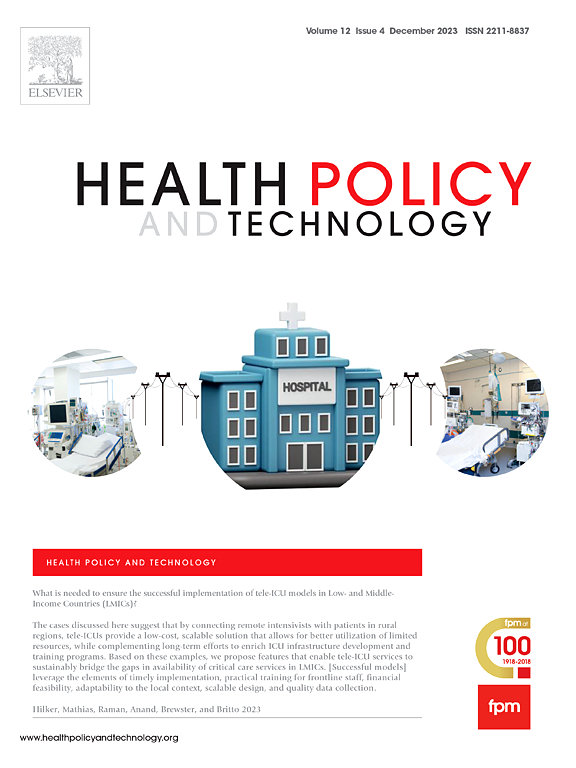The influence of digital health technology on the allocation of regional medical resources in China
IF 3.4
3区 医学
Q1 HEALTH POLICY & SERVICES
引用次数: 0
Abstract
Objectives
Digital health as a service innovation benefits society. However, because of a wide variance in information literacy among individuals, reliance on this technology raises more medical equity issues. This study investigates whether digital health service innovation improves the allocation of medical resources at the regional level in China.
Methods
This study collected data from the China Statistical Yearbook and China Health Statistical Yearbook from 2011 to 2020 and an online health service. Then, using the Gini index and a thermal map to analyze the impact of service innovation with digital health on the allocation of medical resources.
Results
The results demonstrate that, overall, service innovation with digital health has indeed alleviated the problem of allocation of medical resources, especially in terms of solving the problem of medical resource accessibility in remote or rural areas characterized by poor development. However, at the level of refinement, high-quality medical resources tend to accumulate in economically developed regions. In particular, online high-quality medical resources are concentrated in economically developed first-tier cities. Thus, especially for vulnerable groups, this kind of service innovation with digital health will exacerbate the problem of allocation of medical resources due to the intergenerational digital health literacy divide.
Conclusion
Analysis of the advantages and disadvantages of service innovation with digital health is conducive to rational use of medical resources and value creation.
数字卫生技术对中国区域医疗资源配置的影响
目的数字健康作为一种服务创新,造福社会。然而,由于个人之间信息素养的差异很大,对这种技术的依赖引发了更多的医疗公平问题。本研究探讨数字医疗服务创新是否改善了中国区域医疗资源配置。方法收集2011 - 2020年《中国统计年鉴》和《中国卫生统计年鉴》以及在线卫生服务的数据。然后,利用基尼系数和热图分析了数字健康服务创新对医疗资源配置的影响。结果结果表明,总体而言,数字健康服务创新确实缓解了医疗资源配置问题,特别是在解决发展落后的偏远或农村地区医疗资源可及性问题方面。但在精细化层面,优质医疗资源倾向于在经济发达地区积累。特别是在线优质医疗资源集中在经济发达的一线城市。因此,特别是对弱势群体而言,这种数字健康的服务创新将加剧代际数字健康素养鸿沟所带来的医疗资源配置问题。结论分析数字健康服务创新的优劣势,有利于合理利用医疗资源,创造价值。
本文章由计算机程序翻译,如有差异,请以英文原文为准。
求助全文
约1分钟内获得全文
求助全文
来源期刊

Health Policy and Technology
Medicine-Health Policy
CiteScore
9.20
自引率
3.30%
发文量
78
审稿时长
88 days
期刊介绍:
Health Policy and Technology (HPT), is the official journal of the Fellowship of Postgraduate Medicine (FPM), a cross-disciplinary journal, which focuses on past, present and future health policy and the role of technology in clinical and non-clinical national and international health environments.
HPT provides a further excellent way for the FPM to continue to make important national and international contributions to development of policy and practice within medicine and related disciplines. The aim of HPT is to publish relevant, timely and accessible articles and commentaries to support policy-makers, health professionals, health technology providers, patient groups and academia interested in health policy and technology.
Topics covered by HPT will include:
- Health technology, including drug discovery, diagnostics, medicines, devices, therapeutic delivery and eHealth systems
- Cross-national comparisons on health policy using evidence-based approaches
- National studies on health policy to determine the outcomes of technology-driven initiatives
- Cross-border eHealth including health tourism
- The digital divide in mobility, access and affordability of healthcare
- Health technology assessment (HTA) methods and tools for evaluating the effectiveness of clinical and non-clinical health technologies
- Health and eHealth indicators and benchmarks (measure/metrics) for understanding the adoption and diffusion of health technologies
- Health and eHealth models and frameworks to support policy-makers and other stakeholders in decision-making
- Stakeholder engagement with health technologies (clinical and patient/citizen buy-in)
- Regulation and health economics
 求助内容:
求助内容: 应助结果提醒方式:
应助结果提醒方式:


